#ancient elvhenan
Text
I have this headcannon that the veil weakened the elves significantly that’s also the reason why half elven children don’t look like their elven side. The veil has caused the elves to loose vital “nutrient” for them to grow well. That’s the reason why ancient elves are so much taller in comparison to modern elves.
#dragon age#dragon age inquisition#elves#dalish#elvhen#elvhenan#dragon age origins#dragon age 2#dragon age inquisition trespasser#ancient elvhenan#elf#fenris dragon age#solas#solas dragon age#solas dai#zevran arainai#veil#the fade
79 notes
·
View notes
Text
Recommending Memories in the Dust by about2dance
Very cool head canons about Ancient Elvhenan in this short story by @about2dance Love the lore around hair, memory beads, and vallaslin-centered compulsion. Also, An'da is a great OC! Brave and sweet. A wittle smol sweet baby I want to hug. And the angst is sooo thick!
Read on AO3 ->
I also read this as part of my commenting sprint for @justleaveacommentfest
#dragon age fanfiction#dragon age fic#commentweek#justleaveacomment#my friend's fic#my friend's oc#ancient elvhenan#elf lore#cool dragon age head canons#solavellan#solas x oc#papae solas
3 notes
·
View notes
Text
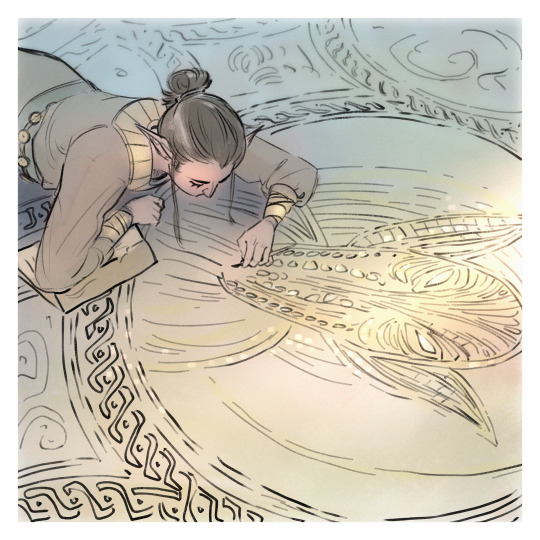
Elgar'nan's temple workers duties
239 notes
·
View notes
Text
Dragon Age Iconic Patterns: The Sun

In this post I will try to extensively gather all the sun-based or sun-like imagery that we find in all the games of Dragon Age. From the most typical ones to those which may seem obscure or with a hidden allegory/design. I will qualify their resemblance with the Sun symbol as Strong, Weak or other.
This post contains the following symbols
Chantry Sunburst
Elvhenan Culture: Sun symbol among the Evanuris
Elvhenan Culture: Asterisk Symbol and Elvhenan Doors
Elvhenan Culture: Golden Ring
Elvhenan Culture: Crappy Sun
Elvhenan Culture: Elgar’nan and Sylaise
Elvhenan Culture: Murals
Tevinter Culture: Green Star
Tevinter Culture: different decorative elements
Dwarven Culture: Fairel and Dwarven art
Ferelden Culture: The Sun Face and the geometrical Sun
Grey Wardens and the Sun
Avvar and the Sun
Flemeth
Qunari, Par Vollen, and the Solium Constellation
DAO design
Free Marches Rural Areas
[This post belongs to the series “Analysis and speculation of Statues”]
[Strong] Chantry Sunburst
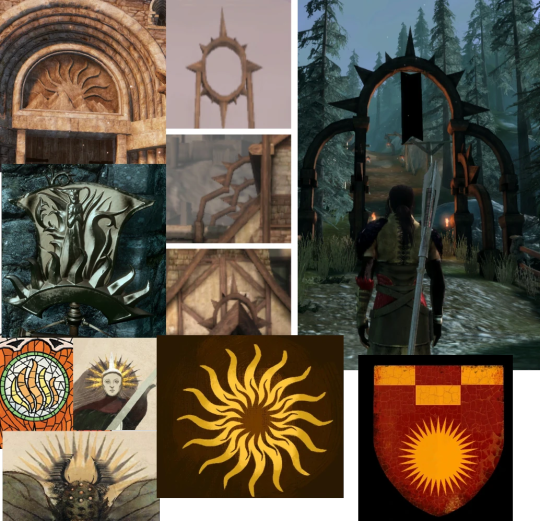
The most typical one that appears in DA series is the Sun or Sunburst with wavy rays, repeated so much along the games that we can identify it immediately. It’s the unequivocally symbol of the Chantry. We found it in many versions, and it represents the “dawn” with the idea of hope and “new beginnings”, but also the fire that “purified” Andraste in her pyre to let her ascend to the Maker’s side. In the posts of Andrastian Art [Andrastian Design: Stained Glasses], we also find that “balls of fire” [which can be interpreted as a Sun in another way] are shown to represent the Maker or the Faith in Him.
Andraste’s single spiked helm seems to be inspired in a single sun ray, at least this is what an illustration in the Chant of Light [book of World Of Thedas] seems to suggest.
In general, most of the representations of the Chantry Sun have 16 rays.
The same sun-like symbol appears in its Tevinter version when we see the Imperial Chantry; the only difference with the Orlesian one is that the Tevinter Sunburst has straight rays.
As a detail, in DAO, we had the typical representation of the wavy sunburst present in some strange devices of Tevinter origin, for example, the ones we found in [Brecilian ruins], while the main Church in Denerim, or in Haven, display spikes that, more than resembling a sun, look like thorns or even a thorny vine. This may be a consequence of an original plan in linking, design-wise, the chantry symbology with the thorny vines that represent the Blight or the Darkspawn [As we explained in the section “Non-mural symbol: Thorny vines” from Murals in DAI: Basics], or merely it was a limitation of the design of the game, as we know DAO suffers from.
We also know that tranquils should display this symbol on their foreheads, burnt with lyrium, but as we saw along DAO, none of them had it. Later we were informed that the devs had problems to add this mark on the npc, therefore, it was never shown until DA2. When it comes to this symbol, it is interesting to see that tranquils carry the metaphor of “a Sun burning their minds and emptying them”, which may or may not be related with Dwarves and their fear to the Sun and potential relatinship of Elgar'nar shoving a fire ball into their underground lands [More details of this concept in Deep Roads [DLC Trespasser]: Lower Walkways in particular with the codex Torn Notebook in the Deep Roads,].
[Strong] Elvhenan Culture: Sun symbol among the Evanuris

Strangely close to the Chantry Sunburst symbol, we find the “half” sun symbol [tagged along the blog as Sun-head creature] in what we suspect was one of the ancient primordial dragon symbols that some Evanuris took over when they claimed Divinity [for more context, read Attempt to rebuild Ancient Elvhenan History]. It’s hard to say which Evanuris took control of this symbol, but we know there is a clearly sun-like symbol present in the Crossroads of the DLC [as a statue, check The Crossroads [DLC Trespasser]: Entrance] and in the Shattered Library [as an Eluvian, check Shattered Library; Entrance and Courtyard]. With the release of the Vinyl, we also discovered and reinforced the hypothesis that this symbol belongs to or was co-opted by an Evanuris [read Speculations about the Vinyl Art for details] thanks to the image of an elf wearing a hat with that shape.
A consistent detail of this image is that it’s a half-sun with exactly 7 rays.
[Weak] Elvhenan Culture: Asterisk Symbol and Elvhenan Doors

If we extend this imagery, and check other symbols that may look similar to a sun, we find the ancient Elvhenan Doors [Elven Ancient Shard-based door], which top displays a pointy sun of 8 rays that may or may not be related to the Asterisk symbols [also related to the Titan’s core, which I talked about in the post of Murals “The Death of a Titan”]. In the way the door gets illuminated when activated also makes us see a “circle” in it that can be loosely related to the “Golden Ring shape”. More details about this ring will be treated below.
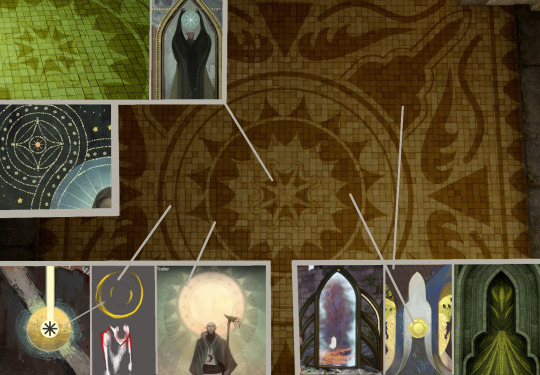
This strange sun on the ancient door also makes us think in the Asterisk Symbol [made of 8 points], which lays at the centre of the yellow mosaic, which may be related to the core of a Titan [asterisk of 8 points too]. The link is immediate when we see that this asterisk is outlined by a shape that looks like a star or a Sun, inside a big ball with triangular-shape ends. This same symbol appears in the last Trailer of DA4, behind Solas, when he is presented like an Hermit, mysterious, apostate mage. Around this “sun” we can make out several concentric lines that may refer to a “Golden Ring”.
The Asterik symbol also appears in murals such as “The Creation of the Veil” or “The Death of a Titan”, which allowed us to relate them with the core of a Titan and its immense power of "making real what you imagine"reinforcing the reality", but this symbol also appears in a corner of Solas’ tarot card.
The yellow mosaic also has some shapes at the four corners that may represent eluvians or something related to Mythal. In the mural of “the Temple of Mythal” from “The actions of the Inquisitor”, we see that Solas draw a particular star of 8 points inside a door frame that resembles this “eluvian outline”, but it’s also the shape of the doors of the Temple of Mythal which represents Mythal herself in her dragon shape. All these symbols seem to reinforce the idea we explored in “The Death of a Titan”: Mythal seems to be related to the core power of a Titan represented by an asterisk that evolves into a golden ring and into a sun.
As I repeated several times in Speculations about the Vinyl Art, at times, we find some hints where stars or balls of fires [also understood as suns] are related to Mythal and Elgar’nan, making us suspect that, maybe, Mythal and Elgar’nan share a nature similar to Falon’Din and Dirthamen’s: apparently, the same creature with two different aspects from them. If this were the case, associating Mythal with the Sun would make sense, and it would also explain why, if Elgar’nan was so central in the Elvhenan culture, there are so few representations and statues of him, while Mythal overwhelms it.
[Weak] Elvhenan Culture: Golden Ring

During the last trailer of DA4, we see Solas turns into the Black Dread Wolf as a sun in the background becomes a moon [single golden circle] and later, it separates itself into concentric rings, that may or may not be related to the “Golden Ring” so deeply entangled with Elvhenan culture. Thanks to this imagery, we may relate the Sun to the Golden Ring [specially if we consider that the mural presented in Nation Art: Elvhen displays the yellow ring in a position that may be considered “the sun”, but also the "authority/power above"]
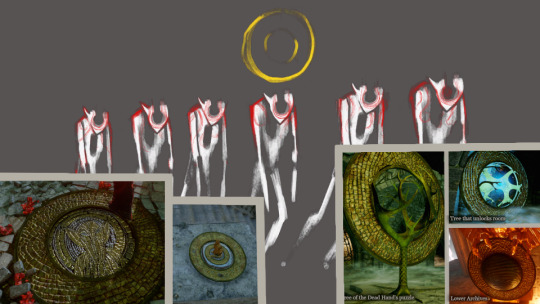

We need to remember that the Golden Ring’s presence is always associated with control, power, and occasionally to Mythal and Dirthamen. In the mural of the “zombie elves”, it’s above all of them, and due to this position, it could be interpreted like a “sun” or moon upon the controlled, zombified elves. But I’m not too convinced in this interpretation, since we already explored in posts such as: Nation Art: Elvhen, Exalted Plains: Ghilan’nain’s Grove and the Dead Hand, DLC: Jaws of Hakkon - Frostback Basin, Elvhen Tomb, Ancient Elven codices; Fen’Harel’s mountain ruins, The Crossroads [DLC Trespasser]: Elven Mountain Ruins; Vine-covered Tower, Murals in DAI: The Death of a Titan, and Speculations about the Vinyl Art that this ring was more related to control, power, or even forced change/shape in some cases. Due to its power or potential knowledge, it's also associated to Dirthamen Owl [which also could be Andruil's owl according some inconsistencies in the same Unreliable Dalish legends].
On the other hand, it’s never clear if this symbol may have morphed into a sun along the ages with the loss of memory that the Elves had throughout generations when they lost their immortality. However, I tend to consider that this Golden Ring may have changed into a Sun when it entered in contact with human groups, in the same way that I see the story of Fen'Harel gave enough context for humans to create the Maker myth based on him, potentially during the time of Halamshiral [for more details, read The Chantry and the Mythology of the Chant of Light]
This ring also appears in the last scene of DAI, when we defeat Corypheus, showing Mythal inside it, as bits of red lyrium sprout around it. This can be related to many speculations done in Speculations about the Vinyl Art, where we can conclude that another fragment/part of Mythal is still trapped in the Black City, corrupted, and contained by an immense power that may have been used before by the rest of the evanuris to control their own people.
The Golden Ring has also been seen enclosing Elven Tree Statues and Elven Orbs, implying its relationship with elvhenan power and/or Mythal’s [after all, we know that Mythal took the power from a Titan from which elvhen orbs were developed, and trees are also her symbol, according her vallaslin]. It's worth noting that the only working orb we saw in the game was Mythal’s, so far.
[Weak] Elvhenan Culture: Crappy Sun
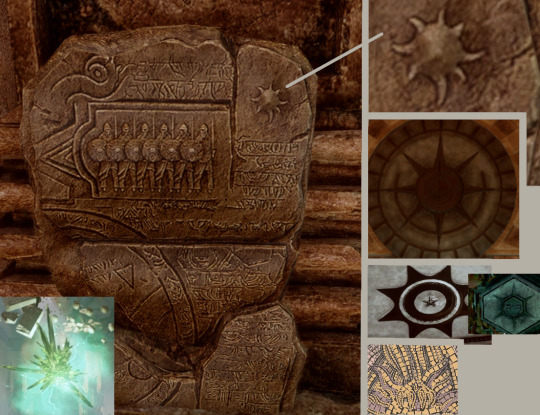
There is also a strange symbol that I called “crappy sun” in the ancient tablet we find at the entrance and deep into the tomb of Forbidden Oasis: Solasan Temple [along this blog I’ve tagged it as “Stone in Razikale-Ceremony-style”]. It’s hard to say if it represents a sun or a breach. It may be related to a sun similar to the one of the Elven Ancient Shard-based door that, later, Tevinter co-opted to turn into the several versions of pointy suns we see in Tevinter Pre-blight ruins, [let’s remember they were not Andrastian yet, and still they had this symbology in their buildings and elements because it may have been related to ancient dragons, or taken from another elvhen symbology during the time of the Dreamers since there are some proofs, such as the Tevinter Mosaic [Invasion], that may show that Tevinter had a better relationship with elves back then].
Maybe the original symbol was related to Elgar’nan, as we see in his mosaic, where he shoves down the sun into the earth, and its rays are wavy and a bit “crappy”. If this relationship is correct, maybe what Elgar'nan shoved into the Earth to destroy the dwarves/Titans was not a sun but a breach? Again, a very unlikely hypothesis.
This “crappy sun” also has 8 rays.
[Strong] Elvhenan Culture: Elgar’nan and Sylaise
Elgar’nan’s mosaic was interpreted in the post Evanuris, and basically shows an elf shoving down a Sun of wavy rays into the Earth. It’s easy for us to relate this image to the unreliable Dalish legend of Elgar’nan [read Elgar'nan: God of Vengeance]. Elgar’nan is presented here as the son of the Sun itself, who tried to burn all life on the Land out of Jealousy, so Elgar’nan vowed vengeance against his Father’s cruelty, and his rage won against the fire of the Sun. Then, “Elgar'nan threw the sun down from the sky and buried him in a deep abyss created by the land's sorrow.”
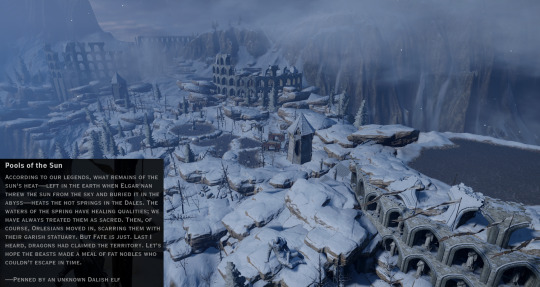
This story can be followed later in the post Emprise du Lion: Pools of the Sun, where we find another unreliable Dalish legend claiming that this place has spring waters because it was here where Elgar’nan shoved the sun into the Earth. I also made a link to Sylaise considering the Elvhenan arenas we can see in this region, the presence of Sylaise’s Shrine, and her thirst for being always competing with someone. These details can make us suspect that this Sun could have been Sylaise [so deeply related to fire, the sun, and also as angry as Elgar’nan according the Song to Sylaise].
It’s very worth noting that these two legends, said by different clans, claim that Elgar’nan pushed the Sun into the Abyss. Another detail we have to assume is that "Abyss", "Beyond the Deep Roads" and "The Void" seem to be one thing related to the places where the Titan sleep [or even inside the Titan themselves] instead of a strange dimensional pocket we never saw before. This links the Elvhenan with the Dwarven in what we speculated in Murals in DAI: The Death of a Titan.
With this relationship, we see again the Sun as a weapon of destruction and control.
[Weak] Elvhenan Culture: Murals

Murals present a red sphere with rays that may imply a Sun .
In the mural “The Creation of the Veil” [1], we find a red sphere inside a black one, making us suspect it’s the big evil released by the Evanuris that Solas isolated with the creation of the Veil. Around it, there are seven “bubbles” with similar “rays” in grey and golden colours that may imply “gates” that would allow us the access to the central “sun” or red sphere.
In the mural “The Death of a Titan” [2] we talked extensively about the asterisk symbol, its representation of a Titan’s heart and all that power associated with it, as well as with Golden Rings. The codex in here speaks of a red sphere that contains fury, and maybe all of this can be related to a sun, or better said, the other way around: a Sun as a sphere of fire, related to fury, and buried below underground to contain its destruction. This also brings us some similarities with the unreliable Dalish legends about Elgar'nan.
In the mural “Red Lyrium Idol” [3] we also commented how the image looks as if Solas were walking on a sphere of fire. It may be related to the red lyrium idol too. Here, we keep linking this idea of a “sphere of fire” as a potential Sun.
In the murals of “The actions of the Inquisitor” [4], we see several times that the red sphere associated with the big evil isolated behind the thick, impenetrable barrier of the Black City seems to be positioned in places that may allow a soft interpretation as a “sun”in the sky.
These symbols seem to gather more importance as we analysed the Vinyl Art, where we find the concept of the Eclipse [as an ominous symbol of Fen’Harel that covers and hides the Sun] and a lot of iconography of stars, which can be interpreted as “suns”.
[Weak] Tevinter Culture: Green Star

Pre-Blight Tevinter art has a “star” symbol that may be interpreted as a sun, specially if we consider that the inside of this green star displays the symbol of the elvhenan Golden Ring in red colour. However, it seems more likely to be a symbol representing the power that one can extract from the Breaches. The green colour helps in this interpretation and puts it a bit farther away from a sun interpretation than other symbols. However, it keeps linking the Golden Ring with the power of creating a Breach.
[Confusing] Tevinter Culture: different decorative elements
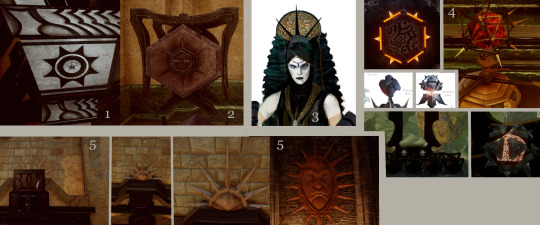
The rest of the symbols in Tevinter objects may have some relationship with the Sun. For example, we find doors, boxes, and columns decorated with an 8-pointed star [1] but we also find another one with 6 points in something that looks like a box [2]. The shape of an “hexagonal” sun of 8-pointy rays can be found as well in objects like the “scrying orb” [4].
Among the outfits, we find a 3-ray comb used by Tevinter women [3], which may be related to the sun-based symbol of an Old God [and potentially related to the corresponding Evanuris associated with it]. This symbol is a lot closer to the "Sun-head creature" we found among Elvhenan objects.
As a curious one, I will always point out the strange, hidden Sun figure that belongs to the Free Marches decoration that can be found at the entrance of the Inner Sanctum in Western Approach: The Still Ruins, Viridis Walk and Inner Sanctum.
I think it’s clear and safe to say that most of the sun-based symbols present in Tevinter culture [and previous to their conversion to Andrastian religion] may have been originated from the contact with the Elvhenan [during the Dreamer time where we can see less repulsion to Elvhen according the Tevinter Mosaics] or [most likely] with the dragons that may have been related to the Elvhenan, as I made the connection in the comic post The Missing.
[Weak] Dwarven Culture: Fairel and Dwarven art

The Dwarves, at least the ones in the Fairel’s ruins, may have some link with the Sun as well. In these ruins we find the same exact stone tablet we find in the Ancient Elvhenan tombs [1], which displays the “crappy sun” I commented above. Once again, it could be a sun but also a breach, so there is no much sense to keep focusing on it.
Another symbol to relate the Sun to the Dwarves may or may not be an old “Dwarven stone-paintings” we saw since DAO, which basically shows a dwarf working the stone [3]. Based on symmetry, we could assume that the triangles on the background are stalagmites, but if we stretch-out this interpretation, they could even be seen as a sun with its rays. It’s very unlikely, since it seems to be more a design resource to highlight the scene of the stone-painting, but for completion’s sake I think it’s worthy to keep it commented here.
However, this simple design allows us to interpret it in different ways: the spikes we see can be pieces of rock protruding from the ground and the Dwarf in it is mining them [as its original codex in DAO seems to imply], but also it could be understood as a quarter of a Sun peeking through the corner of the image as a Dwarf works tirelessly.
Later in DAI we are introduced to another piece of art of similar characteristics [2]. The building was never possible to be identified unequivocally, and in posts like “Architecture of Kirkwall : Gallows and Lowtown/Darktown” I related it to representations of Kirkwall or cities that may be similar to Kirkwall where the runecraft mastery of dwarves was used [and probably, it was a source of pride for these clans, who may have kept the achievement immortalised in a piece of art reproduced among the noble dwarven families]. This piece also shows a background very similar to the one in [3] that may be a representation of stalagmites or a sun, if it’s stretched-out enough.
Another strange symbol in the dwarven furniture is the one presented in some stone-seats: an elaborated metal image that shows thorny vines on or over a sun [4]. This symbol appears in many other parts of the game where there are dwarven rooms, but also in Arbor Wilds :Cradle of Sulevin where we can read the Vir Tanadhal, However, in this case, the symbol is not completely the same one than in the Hissing Wastes: Fairel tomb.
It’s hard to suspect if this is a mere reuse of assets, it has a lore-related meaning, or it’s just a reflection that the Dwarves and the Ancient Elvhen had a relationship quite ancient [as it shows the Elvhen tree and its dwarven, more geometrical style, that I’ve been pointing out since DAO in Orzammar]. We have to remember that the Ancient Elvhenan saw the dwarves as soulless creatures, workers of the “pillars of Earth” and worthless. However, I always claimed it was never clear if this was a reference to ancient Dwarves that were linked to the Titan deeply to the point that they became Sha-Brytol after the break of the link, or were related to more independent dwarves as the ones we see now, who have a sense of Stone, but can’t understand the Titan with the exception of some gifted ones [such as Valta].
Finally, the dwarves have an additional aspect related to the Sun in the very unreliable codex called Torn Notebook in the Deep Roads, Section 2. I wrote about this codex in a more integral way in Deep Roads [DLC Trespasser]: Lower Walkways. But basically an ex-Dalish elf [now a Qun converted] relates Elgar’nan’s fire [which another unreliable Dalish legend, Elgar'nan: God of Vengeance, claims he shoved the Sun into the Earth] to the fear to the Sun that Dwarves experience [Read the section Elgar’nan and Sylaise above]. This may have been a Dev’s choice to makes us aware that there exists a relationship between the Sun and the dwarves, even though there is no lore material that can make it clear enough.
[Strong] Ferelden Culture: The Sun Face and the geometrical Sun

In the Tryptich presented in Andrastian Design: Tapestry and Tryptich, we find three symbols on top of each part of the scene: the six-snakes that represent Tevinter, the golden city above all the image representing the Maker or the Chantry Religion, and over the section of Ferelden/Orlais chantry, a 8-pointed sun which rays look like triangles. Once again, the resemblance of this symbol with the elvhenan sun in the mural “Temple of Mythal” is remarkable [check the Temple of Mythal in “The actions of the Inquisitor”] or the sun shape in the elvhenan yellow mosaic or in the background of Solas in the Trailer of DA:D. This could come from different roots:
1- An Orlesian root, considering how much of the elvhenan influence it had during the time of the Halamshiral and the coexistence of humans and elves in the Dales for some years [to the point where inter-racial families were made, as it was hinted all over the Exalted Plains]. I spoeculated how the idea of the Maker may have been developed during this time in the post The Chantry and the Mythology of the Chant of Light
2- Another potential root is related to the Alamarri root, and therefore, linked to the Avvar: this sun may be a representation of the Lady of the Sky for the same reasons I will explain below in the Section Avvars and the Sun.
We can find similar icon in the book World of Thedas, where they show a unique Ferelden Tryptich [3], which top displays this symbol with a sun that even may have a shape of a Golden Ring within it. In either case, we know that this symbol later was part of the Ferelden Chantry, which sun is very pointy, as DAO showed it [see the first section in this post: Chantry Sunburst].
In DAI, we find in some small towns of Ferelden, a unique strange Sun with a crying face [1]. On it we see a bird and a squirrel. It’s hard to know exactly what this is, [check the post Nation Art: Ferelden], but maybe it can be understood as a representation of Andraste made by Ferelden culture mixed with some local animals and fables created as a mixture of cultures, similar to the tale that related Wyverns to Andraste [check the wyvern section in Dragon Age Iconic Patterns: The single spike].
There is also a fish drawn in the DLC of Hakkon on a fisherman shack [2], which displays a pattern that can be related to the “crappy sun” designs on its skin. Not sure what to make about it. The closest is that the Avvar represented this symbol as a way to reflect what they may have seen in the Isle of the Lady, where a big ancient breach have been there, open, since the time of Telana [read about this in “The Veil and the preservation of the Waking World” from the post Frostback Basin [DLC]: Miscellaneous ].
[Strong] Grey Wardens and the Sun

The typical symbol of the Grey Wardens involves a chalice that represents the Joining ritual. It always displays a Sun, and not any sun: it’s one with a strong resemblance to the Sunburst of the Chantry. Let’s remember that the Grey Wardens was and is an independent Order that doesn’t respond to the Chantry, and even more so: it was created before the existence of the Chantry, and before Andraste was born. So any quick explanation that this sun is present in this object due to some potential influence from the Chantry seem unlikely.
However, as I showed in Western Approach: The Still Ruins, Main Chamber and Hall of Silence, there are griffons with this same chalice that belonged to pre-Blight Tevinter, maybe remotely associated with Dumat in some ways [since they appear in a hall called “Hall of Silence”, and Dumat=Silence]. We know that the Joining, as a ritual of blood magic, came from the knowledge of Arlathan elves and Tevinter Mages during the desperate times of the First Blight when nothing seemed to stop the darkspawn and even slaying Dumat did not work the first time. Therefore, this Sun may have some relationship with the elvhenan, the Old Gods, or just the blood magic that allowed the creation of the Joining.
[Curious] Avvar and the Sun

The Avvar have a symbol that I always found very Sun-like due to its design and cultural concept: The Lady of the Sky. It’s not only the concept; the lady of the sky can be any important object in the sky; moons or suns. Since Thedas has two moons, it seems more plausible to think of her as unique as the Sun itself.
In the painting that represents her (found on a wall in the Frostback Mountains) we see a design of an owl which shape looks like a Sun. Even her sculpture in Skyhold displays small spikes around her neck which give her a low-key “sun-like” design, specially if we relate this shape with the “sun” shape we saw in the Ancient Elvhenan Yellow Mosaic or with the star we saw in the “Temple of Mythal” mural [in “The actions of the Inquisitor”] or with the Sun that appears behind Solas in the trailer.
Curiously, her banner displays her eyes in a shape that looks similar to the Golden Ring shape, but in black colour. That the Avvar have an art that may have resemblance with Elvhenan's is not strange for me if we remember that Tyrdda Bright-Axe Path’s story narrates that her lover was an elf that, as it is hinted, may have been the Lady of the Sky herself. This means that the Avvar always were a culture under the influence of the Elvhenan and the Dwarves [due to the marriages they arranged with the children of the Stone].
[Weak] Flemeth
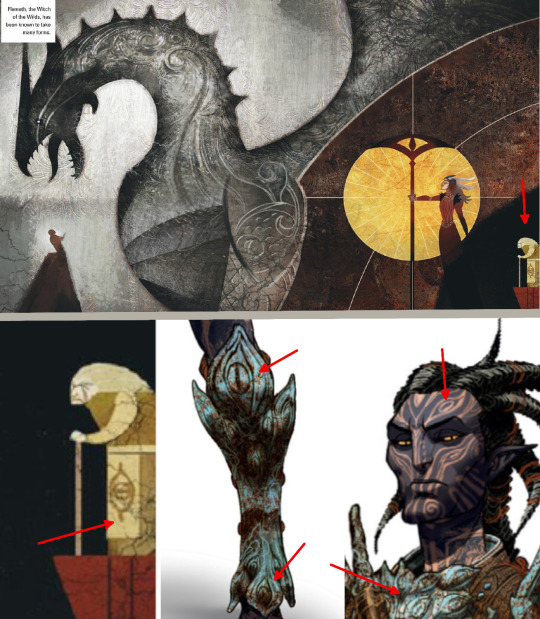
Flemeth also had a unique concept art that shows all of her nature in one drawing: her dragon shape, Mythal, as the central part of it over a human figure that may be a petitioner; a bit aside and as if she were in a inner ring of a brown sphere, The Witch of the Wild: Flemeth, with a very particular staff inside a yellow circle that may be interpreted as a Sun. And very hidden in the corner, in the core of this sphere, now black, we see her as an "old, old woman" with a big eye drawn on her apron, at the edge of a cliff [potentially representing the fragment of Mythal that lives inside her]. This kind of eye is very similar to the ones that we see in the concept art armours of Mythal’s temple guardians. I assume it has to do with her omnipresence due to the manipulation of dreams [we know that she presented herself in dreams to an elf and marked him with the Vallaslin of Mythal after awakening, check the video]
Mythal also has bland hints related to Elgar’nan symbology, which is related to the sun, fire, and balls of fire with anger [check all this in the posts Speculations about the Vinyl Art and “The Death of a Titan”]. Flemeth ends up being related to all this since she carries a fragment of Mythal in her.
[Strong] Qunari, Par Vollen, and the Solium Constellation

The Qunari have little link with the Sun, but not the land they conquered. In the book World of Thedas we are informed about the existence of the Fex, a race we never saw nor had much information beyond the fact that they exist. May they be related to the Sun or a Sun-base proto religion? We don't know.
In the Codex Constellation: Solium, we learn that this constellation [which looks like a Sun/Star, image above, pretty similar to the Chantry Sunburst I may add] may have been a representation of the Sun or the Moon [or both] for the Neomerian [Ancient Tevinters], however, it could also represent Elgar’nan, since unreliable Dalish legends claim him to be the “eldest of the Sun”.
Another Codex, called The Pyramids of Par Vollen, tells us that the Jungles of this continent have ancient ruins that doesn’t seem to be tombs but places of scientific purposes. The shape of these ruins fits perfectly with the constellation of Solium, making them, in some way or another, related to the Sun. These pyramids are a great mystery in the DA lore, especially for their total lack of information beyond this codex. We know their walls show images of “intricate sea creatures, shipwrights, musicians, archers, and kings. Odd figures are depicted, tall, horned, always in a position of authority and respect.” It seems that there was no resistance when the Qunari came to conquer this place, so we can suspect that this previous civilization embraced the Qun without much resistance, in part, because the Qunari have horns, and that caused respect and authority. Or the civilisation had been gone long ago when they came. Or it was a civilisation that was developed by or under the authority of the Kossith, the ancient Qunari who had no Qun.
The brief description of these ruins also makes me link it, potentially, with the underground ruins we find in The Horror of Hormak .
[Confusing] DAO design
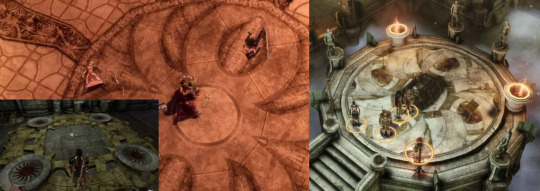
This section tries to relate the Sun shape with designs that may make the connection a bit stretched or not truly reasonable, therefore, DAO leads this part, lol.
We find that many places along the game, specially the ones related to puzzles [Honnleath and Enchanter Wilhelm’s basement] or to Tevinter experiments [Ruins of Brecilian Forest] display a platform on the ground with a symbol similar to the Sunburst of the Chantry. I’m not sure why they are there, specially in the Brecilian Forest, since we know this was a fortress probably developed by Tevinter [ which potentially may have co-opted, as usual, an ancient Elvhenan building and claimed it as its own] just to be taken by Dalish and humans later. This Fortress is a mess in terms of design and statues that it displays, so it’s hard, if not impossible, to truly take it seriously. To me it all feels more like a reuse of graphical resources, but just for the sake of completion, I add the present section.
More of these sun-like platforms can be found in the Tower of the Circle of Magi [which could potentially make sense since the tower was made by Avvar and Dwarves, and it may be a representation of the Lady of the Sky, as we saw in the Avvar section of this post] but also in the Temple of Andraste or in Denerim at the Fort Drakon which makes less sense [unless it is taken as a symbol from the Chantry itself]. Again, these inconsistencies make me suspect the reuse of assets in a game that could not afford to have 5 different platforms designs.
[Confusing] Free Marches Rural Areas
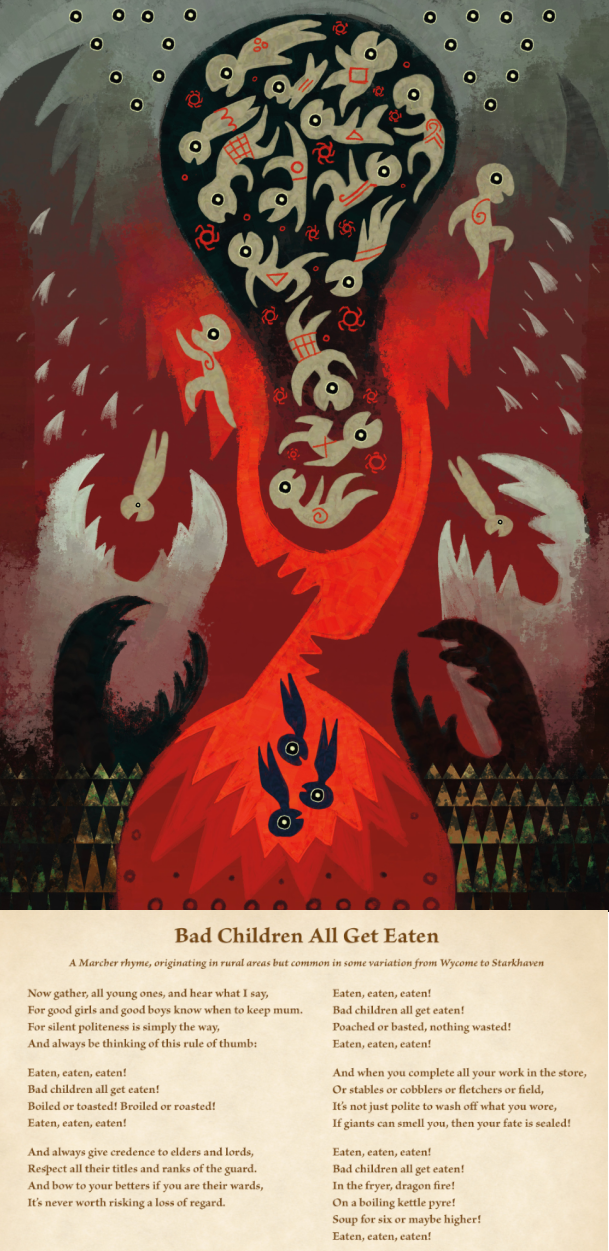
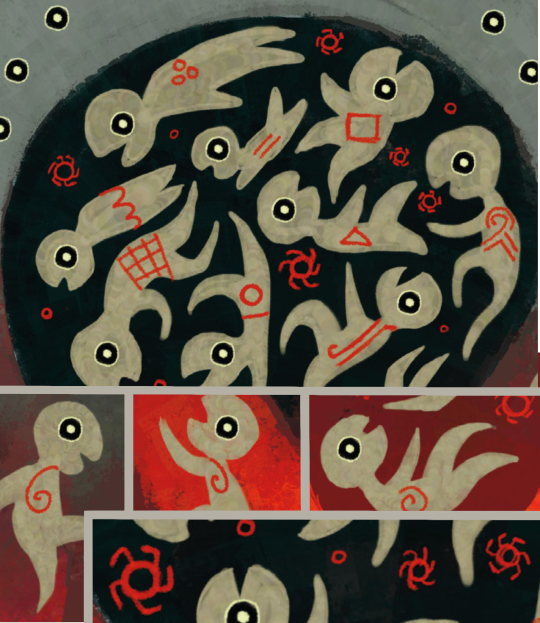
Another place where I found a sun-like symbol was in a very disturbing image of the book World of Thedas associated with a cautionary tale told to Free Marches kids. In it, we see that people/children are punished if they go outside a bubble of darkness with small “sun-like” symbols floating around. Each of these kids have a symbol on their belly or head. Curiously, one of these symbols is a small spiral that I’ve brought the attention upon long ago in the post Hinterlands: Statues, paintings, and structures found in the open where we found the alamarri statue I called Eroded dragon skull which has a “G symbol” on its back, which, at the same time, seems similar to the one present in a reiterative way all over the elvhen artefacts and in some dwarven rug designs.
I don't know how to interpret this image, mostly like the big black bubble that contains these klids seems to protect or shield them from the dangers outside. The kids that "behave badly" are dropped outside of it and are consumed by the dragon fire/jaws of the dangers outside. So in a very stretched way, we can interpret this image that the bubble filled with Suns protects people, or at least, it's the right path to follow not to be eaten by those monsters outside.
Conclusions
To put an end to this post, I would like to bring a short conclusion that we may have reached together along it. The Sun in Thedas is an ancient symbol that mostly every culture took to exploit and use in their own representation of gods/power.
This fact alone is not strange, since in anthropology we can see that severals cultures on Earth have developed religious rites or created Gods out of the Sun itself. The Sun is a symbol related to warmth, light, food, life, and security, so it seems reasonable for DA Lore to take it as the main symbol of Thedas civilisations.
The Sun in current Thedas is immediately associated with the Chantry and Andraste: it is a symbol of hope, of dawn, that provide the idea of new beginnings; it’s also the idea of the Maker itself and the Faith people have in him. It's also the fire that purifies in order to grant ascension [Andraste's case].
When it comes to Elvhenan, the Sun is immediately related to Elgar’nan, who was considered, according to the underaliable Dalish legends, the son of the Sun itself, who in order to save the Land shoved the sun into the ground, potentially causing a great damage to Dwarves and Titans.
There is also a symbol of a half-sun in an Eluvian, a statue, and in a hat worn by an elf, that may suggest that an original god, represented by the sun [potentially an ancient Dragon] was worshipped by the Evanuris. Lately, that symbol may have been co-opted by one of the Evanuris when they took divinity and the identity of the ancient gods they worshiped.
Elvhenan also seem to take the symbol of the asterisk as an oversimplification of the Sun, which across the murals, is also related to the heart of Titans, to power, and to the Golden Ring, which is also associated with control. So, for Elvhenan, we may suggest that the Sun represents immense power, if not, Divinity itself, that may end up being related to the core of Titans. The asterisk is also associated to the orb, a big power object.
Since Elvhenan were the first civilisation we know that started in Thedas [besides the Titans and their children], their symbols of power [asterisk, orb, golden ring] may have evolved along time to reach human groups which developed, later, all the sun symbols that ended up in the Chantry’s.
Thanks to Tevinter, we also can suspect that the Sun may have been a representation of an Old God, since they have a lot of sun-related images in their decoration and objects that belong to ancient times in which they were not Andrastian yet [in fact, so ancient times that Andraste herself was not born yet]. This may mean that the Sun symbol cloud have been taken from the Elvhenan or from the Ancient Dragons. Through Tevinter style, we also realise that the Elvhenan Golden Ring may have been used to create Breaches, which again shows and seems consistent with the idea of relating it to power and control. The symbol of Sun in Tevinter culture may be related originally with Elvhenan or with Ancient Dragons that Tevinter used to worship.
Dwarves have little representation of the sun for obvious reasons, but due to the unreliable legend of Elgar’nan and the war with the Titans, we may establish a relationship in which the dwarves endured the Sun [or the Elvhenan power] at some point in their story.
Thanks to the Grey Warden we can relate a sun with the idea of ancient Blood magic or ancient Dragon blood knowledge, since the Joining is represented by a chalice with a Sun on it.
The Avvar also have a low-key representation of the Sun in their Lady of the Sky, which may be just consequence of their deep relationship with the Elvhenan culture.
Par Vollen may have more answers about the Sun and ancient times, but the lore of DA world is very scarce on this region of the map of Thedas, so we can only speculate.
#Analysis and speculation of Statues#golden ring#alamarri#avvar#Chantry#Dragons#Elvhenan#Flemeth#Grey Warden#High Speculation#Old Gods#Tevinter#Par Vollen#sunburst#Sun-head creature#evanuris#Elven Ancient Shard-based door#yellow mosaic#mythal#flemeth#Elven Owl statue#Stone in Razikale-Ceremony-style#Sylaise#Elgar'nan#Asterisk Symbol#Free Marches Sun#Dwarven stone-paintings#lady of the sky
27 notes
·
View notes
Text
Fen’Harel and Elgar’nan (in that respective order) - Ruthlessness: Epic
This only took me like 30 minutes, but this song gave me a brain worm so I rushed to make it fr

Elgar’nan concept art
I’ve been neglecting my tumblr, my bad ya’ll
#dragon age#dragon age inquisition#art#dai#dragon age dreadwolf#dreadwolf#Elgar’nan#Fen’Harel#solas#Elvhenan#Arlathan#ancient elves
16 notes
·
View notes
Text
i love it when this fandom will unironically act like the dalish are the only "real elves" in dragon age and then also hate s/era for getting pissed off about the dalish because, JUST by being a city elf, she's simply not "elven enough". city elves are elves???
#if anything the amount of dumps dai lore took on the dalish goes to show they're not keeping the lost lore of anything#and they're as in the dark about ancient elvhenan as city elves are#i think some of u get sooo caught up in how ~mystical~ and ~exotic~ the dalish are that ur just regurgitating this nonsense but like ffs#make an effort.#its so funny too when ppl will vehemently insist al/istair is half elven... but only to use it to justify him like... romancing m/ahariel#as the most valid way to 'reconnect' to his cultural roots babes fiona is a city elf 💀#city elf culture is still elven culture 💀#anyways.#tbd#fandom critical
17 notes
·
View notes
Text
Elven Immortality Theory;
It's super late, and my brain did the; I know you're trying to sleep, but have you considered.... THIS?
So, the legendary immortality of the people of Elvhenan.
It always bothered me to consider the idea of what it would mean for them to be immortal, especially when we have so many stories of them maiming/killing one another.
So what were they then? Immortal unless killed? A disturbing consideration I had was that they were straight up immortal; even if you cut off their heads or burned them to ashes; they would still be alive and aware to some degree; and only people with high connections/social standing/magical ability/access to magic healers could fix things like 'well, I'm bleeding' or 'oh, my arm was cut off, let's fix that', so slaves and whatnot were pretty buggered- perhaps another reason to have slaves is to have 'spare parts' around? I don't know.
But I just considered something waaay more interesting.
If we are to believe that the ancient elves were once spirits, who took physical form to feel the physical world and all it's sensations - what if those bodies were still capable of 'dying'?
Allow me to explain;
When people die, in modern times, their spirit/soul leaves their body and seemingly... disperses? Goes to the beyond/fade? Ceases existing? What if that's because of the veil? Spirits can't easily move between Thedas and the Fade because of it.
But before the veil they could.
So what is the danger of losing a body when you're spirit/soul doesn't stray far/stays on this plane of existence, and it's established that your abtract being can just up and make a new body if it wants?
That's immortality, and that's why the elves were ageless; they were spirits who could just make their own bodies?
And then the veil happened, and they became mortal, because they couldn't get their bodies back - those who do....
Dear Andraste, have I just fell down a rabbit hole here?
Are Solas' people the ancient elves -who, by this theory, are spirits/demons???? Are all the elven dead now the inhabitants of the fade, who may/may not be aware of this fact?
What would that even imply in ancient times, though, if they had children? Like, natural conceived and born children? Would they be spirits? Or did they not have kids? They clearly knew how since the modern elves exist...
I just... I need to sleep.
#dragon age#dragon age spoilers#dragon age inquisition spoilers#arlathan#ancient elves#dragon age theory#da theory#elvhenan
10 notes
·
View notes
Text

For the @hanal-ghilan-prompts !!! "Wine".
I absolutely love the concepts of ancient elves without the veil between the fade and that somehow ancient elves could simply conjure things with just a thought. Like wine for instance!
Maybe this could be a form of ceremony or ritual where a priest or priestess would summon spectral wine with ~strange~ properties. Or perhaps it was a party trick used by powerful mages to showcase their power in a form of excess. Who knows! (probably Solas but he's not saying) It's been lost to the ages.
#liquid is surprisingly hard to draw#hanal'ghilan2022#wine#dragon age#dragon age elf#dragon age ancient elven#Elvhenan#I love drawing things in this ethereal kind of look just strikes some notes in my brain#I kinda loosely based the character from my elven inquisitor#maybe it's her ancestor or something?#digital art#digital illustration#dragon age art#dragon age fanart#myart
7 notes
·
View notes
Text
Pride's Hope
Just a wee gift for @dreadfutures. Thank you for inspiring thoughtful introspection and theme when I usually wouldn't give it much weight, and encouraging this thing when I worried it was too navelgazey or cerebral.
Rating: General Audiences
Warnings: None
Words: 1256
Relationship: Felassan/Solas
Characters: Felassan, Solas
Additional Tags: Ancient Elves (Dragon Age), Arlathan (Dragon Age), Elvhenan, Hair Braiding, Friendship/Love, Dragon Age Meta, Solas is Pride, Felassan is Hope, Foreshadowing, Pre-Book: Dragon Age - The Masked Empire, Philosophy, Identity Issues
Summary:
“I wish I could say that was comforting,” Pride murmurs. “Trust can be weighty.”
Hope hums. “So too, my friend, can the burden of being the hope of a god.”
Solas may have always been Pride, but Felassan was not always Felassan. Once he chafed under the mantle of another name.
#my writing#my fanfic#my fanfiction#dragon age#solas#felassan#solas x felassan#hope x pride#arlathan#elvhenan#ancient elves#the masked empire
24 notes
·
View notes
Text
"that elf had your name on her cheek" oh? so that symbol is his name. fascinating
#OOC / HOLLY.#holly watches shows#absolution spoilers#a rune then?#we know dwarven runes are used in Orlais on signs etc because few people can read#makes sense if Tevinter adapted dwarven runes like this too#and then combined it with perhaps the concept of vallaslin from Elvhenan#I know it's been long forgotten that vallaslin were slave markings#but that doesn't mean ancient Tevinter couldn't come upon Something about vallaslin in their scavenging and adapt it#slavery tw
2 notes
·
View notes
Text
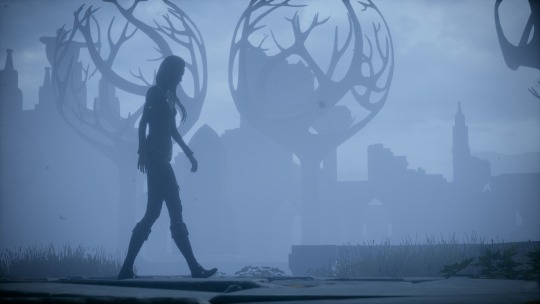


The Place In-Between
#dragon age#dragon age inquisition#evaline lavellan#lavellan#the crossroads#elvhenan#dragon age ancient elves#screenarchery#screenshot#virtual photography
4 notes
·
View notes
Text
more tags. gdi. we’re almost done pals. mythal. ghilan’nain. ghilanna.
#/ sometimes i entertain the idea of orianna and mythal meeting for afternoon tea and i laugh#mythal would think she's just delightful lmao#Mythal. ( ic / answered asks ) ❝ ah? ❞#Mythal. ( ic / musings ) ❝ i don’t rise from the ashes ; i make them. ❞#Mythal. ( ic / aesthetics ) ❝ dwellings of the ancient gods. ❞#Mythal. ( ic / reflection ) ❝ she’s the brightest star of all ; never shall she fall from the skies. ❞#Mythal. ( ic / headcanons ) ❝ and she shall smite your enemies ; leaving them in agony. ❞#Mythal. ( ic / ancient elvhenan. ) ❝ mother of all ; mother of dragons. ❞#Mythal. ( ic / unspecified )#Ghilan'nain. ( ic / answered asks ) ❝ ah; go ahead. ❞#Ghilan'nain. ( ic / musings ) ❝ made of untamable demons ; an unfillable void. ❞#Ghilan'nain. ( ic / aesthetics ) ❝ dwellings of the ancient beasts. ❞#Ghilan'nain. ( ic / reflection ) ❝ mother of halla. creator of untameable beasts. ❞#Ghilan'nain. ( ic / headcanons ) ❝ knowledge is power. ❞#Ghilan'nain. ( ic / ancient elvhenan. ) ❝ this curious head of mine. ❞#Ghilan'nain. ( ic / unspecified )#Ghilanna. ( ic / answered asks ) ❝ it's done. naturally. ❞#Ghilanna. ( ic / musings ) ❝ adventure's not over yet? ❞#Ghilanna. ( ic / aesthetics ) ❝ the moon is not alone ; it’s not the only thing following you. ❞#Ghilanna. ( ic / reflection ) ❝ you can live without the fire ; it’s the heat that makes you strong. ❞#Ghilanna. ( ic / headcanons ) ❝ tenderly all that i adored turned to ashes. ❞#Ghilanna. ( ic / clan sabrae. ) ❝ resilient ; a warrior at heart. ❞#Ghilanna. ( ic / grey warden. ) ❝ never forget what your name means ; remember at every waking turn. ❞#Ghilanna. ( ic / warden commander. ) ❝ keep your wits about you mage ; for true tests never end. ❞#Ghilanna. ( ic / unspecified )
0 notes
Text

Dead Pasts and Dread Futures
by youworeblue
This is my Dragon Age series following Inquisitor Ixchel Lavellan and her battle to find hope for herself, and hope for Thedas.
As the world ends, Ixchel is resurrected under mysterious circumstances and is sent back in time to the Conclave. Ixchel is furious, convinced of her own futility, and yet she cannot give up again. These are the stories of how she gets better.
More info here and on AO3.
Below the cut: the symbolism, and the cover on my Kindle, and in the Archivist bot.
Symbolism:
I previously made some "tarot" cards for Ixchel. In them I feature a motif of eyes/eye shaped leaves, and the number 7. These represent the Old Gods/Evanuris that threaten Thedas.
Kindle e-book Cover:
The cempasúchil are Ixchel's Ardent Blossom later in the fic. They have layers and layers of meaning for her and her story, beyond her being Mexican. In my headcanons, an ancient tradition passed down from Elvhenan, a noble would give their Champion a crown of flowers, an “ardent blossom” of their own, to honor the promise and dedication their Champion gives to them. In Elvhenan, marigolds play a big role in bonding ceremonies of all kinds, symbolizing a promise that will last through an end–whether that end be the end of a corporeal form through death, or through voluntary uthenera, or some other pre-agreed upon ending of a partnership.
Gingko leaves (bottom orb) come to symbolize hope in the story, and remembrance. She teaches Solas and those around her how to take lessons from the past to build a better future, with the world they're given; in turn, her companions give her the strength to survive anything and to see that future come to pass.
I made this specifically to be a cover on my Kindle, where I've started downloading fics! I used calibre and this tutorial (view on desktop) to edit the metadata for the epub and add the cover to my Kindle. It's a little hard to see in the picture but the values turned out really well and legible IMO!
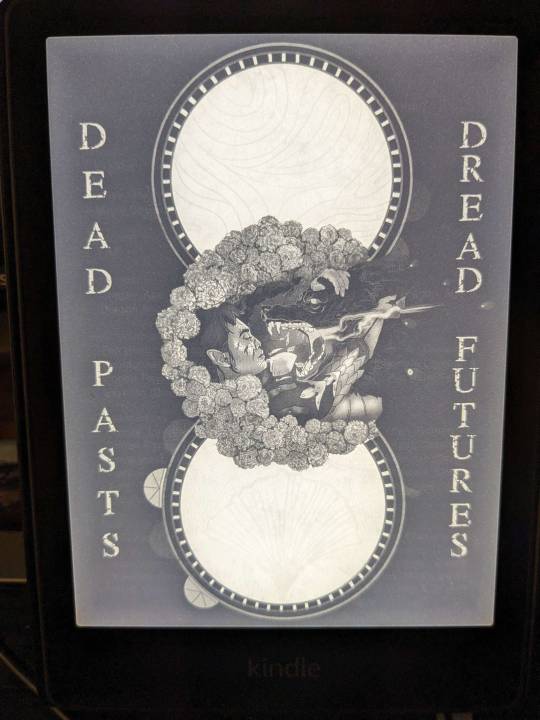
Archivist Bot Embeds:
Also, the Archivist discord bot automatically sweeps the first chapter of your fic and uses any art in it as a thumbnail for its informational embed when you post an AO3 link. Immensely satisfying :)

#dragon age fanfic#dragon age#dragon age inquisition#dragon age fanart#lavellan#inquisitor lavellan#dragon age oc#my art#solas#solavellan#dread wolf#i'm so proud of this!#i've really upgraded and leveled up my art so much in the last year
94 notes
·
View notes
Text

Day 17. Evanuris
#dragon age#dainquisition#dragon age fanart#lavellan#ancient elven inquisitor#inquisitor lavellan#dai#dragonage#da ocs#Thia Da'halla Lavellan#evanuris#elvhenan#inktober#inktober2023
127 notes
·
View notes
Text
Attempt to rebuild Ancient Elvhenan History
Inspired by the comment made by @gemini-press from the post “The Death of a Titan”. Ironically, as usual, I ended up derailing the question and then coming back to it. I’m sorry, lol.

Yes, I think that in the posts of the comics [The Silent Grove, Those Who Speak, Until We Sleep] we are hinted that the worlds were one, so we can be more or less sure about Fade and Waking World being one in the ancient past [Dragons seem to be the powerful creatures that ruled the skies, and everything "sang the same song"]. Where the humans were and from where they come in all this lore is a big mystery still. Some unreliable codex and books of Thedas claim that most scholars in Thedas think humans came from the north, beyond the map of Thedas. The unreliable Dalish knowledge says that humans came from Par Vollen. But we don't know for sure. Probably it will be explored with DA4, located mostly in Tevinter, since Neomerians [ancient Tevinters] were one of the first groups of humans in appearing in Thedas.
Curiously, we have some kind of proof in ancient elven codices that shows the presence of dwarves [workers of the pillars of Earth in Ancient Elven codices, Temple of Mythal and in Ancient Elven codices; Vir Dirthara] in their time but not about the humans. To me is impossible to speculate what happened with the Elvhenan when they saw for the first time the ancient humans walking Thedas/the Waking World. Because, there is no reliable lore about the origin of the humans, so far.
In Seheron there are ancient [apparently human (and Dwarven too) made] pyramids that seem to honour a religion based on the Sun [codex: The Pyramids of Par Vollen], which is related to the constellation Solium, and who knows if this is somehow related to Elgar'nan in a very obscure way? Are humans creations of Elgar'nan? of Ghilan'nain? We don’t even have hints to speculate, unfortunately. The fact that there is a proto-religion based on the Sun in this place only says that Humans may have inhabited this zone first.
Gaider said that in Par Vollen there was a unique horned race called Fex, but it was never explored or mentioned in another official material besides a guide [I think it was DAI game guide? It was a small paragraph that only claimed that there was a race called Fex, no more]. It seems to be a piece of Gaider’s lore that never made it to the canon seriously.
A bit of more lore about Par Vollen can be found in the tabletop corebook, but this source is always a big question if it is considered truly canon or just circumstantial canon for tabletop sessions.
We also have the war between the Evanuris and the Forgotten Ones, but the lack of lore about the latter ones makes hard to speculate about this part of the Elvhenan history where maybe humans may have been started to appear? [I support the idea that the Forgotten Ones may have been called Old Gods by ancient humans].
At some times, the lore seem to suggest that the Forgotten Ones were dragons that the Evanuris worshipped in the beginning but they hunt them down in order to acquire their divine power. So these dragons hid underground, like the comic The Silent Grove seem to imply. In other hints of lore, we can think that the titans were the Forgotten Ones, which, if it’s true, would make the titans dragons too [maybe colossus dragons?], since dragons and titans seem to have similar impressive power and ability to modify reality to their whims. But again, the proof and the links between these entities are really weak and it's too easy to find counter-arguments for rebuttals: think in each creatures' blood for that, lyrium vs dragon blood, and with that we can destroy this hypothesis.
Attempt to rebuilt Ancient Elvhenan History
So, so far, in order to see where the humans may fit, we could attempt to reconstruct the ancient elvhenan history first, which more or less may follow:
- The skies were ruled by dragons [The Silent Grove]. Maybe Titans, and their creations the dwarves, ruled the earth at the same time, but it's not clear. Everyone "sang the same song" [The Silent Grove], which I think it implies that there was an unclear yet harmonious connection between dragons and Titans. Both creatures have similar incredible powers of modifying Reality. Titans "enhance" and almost create the reality [read “After the end of the DLC” in The Wellspring], while dragons can modify it with somniari powers [they alter the Fade which modifies the Reality, details in lore section of Until We Sleep].
- Elvhenan may have worshipped these dragons originally [ancient codices speak of an association between winged shape and divinity in the Temple of Mythal]. We also have a visual hint of this in the mural we see in the comic The Missing, where we can suspect elvhenan, maybe Evanuris, were wearing dragon-like outfits, similar in design to the current Archon’s outfit in Tevinter [a culture that has worshipped dragons since its origins]
- Because the Titans put in danger Elvhenan society by shaping the Stone and making their cities shake [”Song of Elgar’nan” in Temple of Mythal], the Elvhenan made war against the Titans. By this time, the Forbidden Ones [ancient demons] are exiled from the Evanuris’ lands because they did not fight [against the Titans, I speculate] since they seem to like “form”; therefore, they are exiled to the deep Fade [we don’t know what or where it is, but it may be related to a Titan-like space, more details in “Exile of the Forbidden Ones” in Ancient Elven codices; Vir Dirthara]. Myhtal and Elgar’nan seem to display more symbols of victory against Titans [Elgar’nan has a statue in his honour [ Signs of Victory in Ancient Elven codices; Vir Dirthara] made out of stone that simulates a crumbled mountain, a symbol we can assume represents a defeated titan, while Mythal killed one by herself in the “The Death of a Titan”]
- Winning against the Titans gave Elvhenan more power and new skills. It’s not clear what element gave them the biggest advantage, but probably the use of lyrium or of “something else” [speculated to be a titan’s heart or a process related to changing shape, inspired by Ghilan’nain’s experiments that may include lyrium in it]. This allowed the Evanuris to stop being mere war generals and become “gods”, acquiring the shape of their, until that moment, worshipped gods: the original dragons that ruled the skies, or beign able to modify everyone’s else shape as a sign of power [as The Horror of Hormak seems to imply]. A lot of details and other speculations on this matter in “The Death of a Titan”. From this moment on, Evanuris warred against each other in order to have more and more followers.
-There is a potential danger that this obsession in acquiring “divine shape/power” and control of other beings may have induced the Evanuris to produce experiments as the ones narrated in The Horror of Hormak [General] and The Horror of Hormak [Personal Speculation]. So, they may have created the Blight or Red Lyrium, or some other disease previous to these ones that was hidden by Solas and his followers, when they collapsed some rooms underground. The immense rejection to the Blight and Blight magic that Solas has [Solas sharing Lore: read Part 2] seems to encourage the idea that the Evanuris may have created the Blight with these experiments. More concepts around the Blight in this ask.
- Once the Evanuris had “divine winged shapes” [Falon’Din was Winged Death, check his song and Elgar’nan’s song in Ancient Elven codices, Temple of Mythal], they did not need the original dragons anymore, so they hunt them down [Andruil was obsessed with hunting down the Forgotten Ones in Ancient Elven codices, Temple of Mythal].
The original draconic gods may have been rejected and forced to be called “Forgotten Ones”--forgotten from history--so the Evanuris could have their divine place. That’s how Andruil may have gone to the “Void” to hunt them down. We know that the Void is closer to the Depth of Earth than to a pocket-dimension thanks to the analysis of the words Abyss and Void in “Elven God Andruil” from Temple of Mythal and The Uncharted Abbys, Bastion of the Pure.This means that the Dragons hid underground, to hibernate in safety, and Andruil went to the Abyss/Void, returning with madness [probably contaminated with raw Lyrium, The Blight, or whatever disease their previous experiments caused underground]. As a side-comment, I want to highlight that the only hint we have to assume the Forgotten Ones as Dragons is Hakkon himself: it was hinted in all the DLC that Hakkon, a dragon made out of Fade, was also a “forgotten” entity called Geldauran, that had a deep resentment against some of the Evanuris [details in Frostback Basin [DLC]: Elvhen Tomb]
- It seems likely that, since Mythal was naturally a dragon, the Evanuris may have tried to experiment with her too, and caused her death in a corrupted way [as the Red Lyrium idol seem to suggest], spreading a further more complicated diseased in the process. It is also likely that, since Mythal was the one who stole Andruil’s knowledge of how to reach the Void to hunt down the Forgotten Ones, Mythal was killed because she was protecting the Forgotten Ones. If the Forgotten Ones are the Archdemons/Old Gods, this hypothesis seems to fit this strange interest of Flemeth in protecting Urthemiel, “what once was”. Flemeth also taught Yavana whose role was to protect a grove of dragons. Flemeth seemed to have a strong interest in preserving dragons and ancient beings.
- The assassination of Mythal was somehow related to the power-thirst of the Evanuris, so Solas decided it was enough and banished them in an Elvhen City, the one we know as Golden City. Due to the corruption that potentially Andruil had, they all may have become corrupted/blighted. They seem to be the voice/song that all blighted creatures listen and think it comes from the Archdemons, but the true origin of this song comes from the Black City [this info comes from Avernus in Soldier’s Peak]. So the song we always heard along the games may likely be the Evanuris trapped in the Black City. They may also be the whispers in the Red Lyrium too. A lot of these ideas were worked on in the post: Songs and elements that sing and whisper in DA Lore. There is also a chance that the Black City doesn’t only trap the Evanuris, but the corrupted aspect of Mythal herself, when the Evanuris tried to take her divinity or kill her for experimentation or power. This hypothesis was recently developed in Speculations about the Vinyl Art.
- Solas isolated the Evanuris [and potentially a corrupted Mythal too] and the source of the disease that was going to destroy the world [and according to his words about the Blight in Part 2, it seems that The Blight is the biggest problem of Thedas]. He separated the worlds; Fade and Waking World became two different spaces, causing the crumbling of many elvhenan cities that had a deep connection with the Fade [like the Shattered Library]. Due to the weak hints in unreliable codices of Dalish knowledge, we can speculate that Solas may have sealed the Evanuris in Arlathan, and hid it underground [Ancient Elven codices; Din'an Hanin– Elgar’nan Bastion], gates protected by dragons/forgotten ones who are naturally resistant to this disease, deep below the Deep Roads. He also hid the city’s reflection in the Fade, producing a barrier that makes impossible the access to the Black City reflection from the Fade. It seems that, whatever the Evanuris managed to do and create, was so devastating that Solas used every bit of his energy to isolate it in all worlds, [even the reflection of it] so nobody would be ever tempted again to use such power.
- It is not clear if Red Lyrium appeared when the Evanuris used Titan’s power to acquire “divine shape”, or was an unexpected consequence that Solas may have accidentally caused when he hid the corrupted city with the evanuris sealed in it deep underground. So far, there is lore that claims that Titans are immune to darkspawn and The Blight [The Uncharted Abbys, Bastion of the Pure], but then again... there exist red lyrium [which is blighted lyrium, if we can trust the only source we have for this info: Bianca and her unknown source]. So there is a big chunk of lore we don’t have yet that should exist to make both facts consistent. I’m more inclined to think that Solas caused it accidentally, when hiding the city deep underground; he may have forced the corruption of a Titan from where Red Lyrium came out. So far we know, the first sights of Red Lyrium were in DA2, close to the coast of Kirkwall in the Primeval Thaig and, potentially, in Kal'Hirol: First sight of Red Lyrium, both places are close to one another.
-With the disappearance of the Evanuris, and the creation of the Fade, Elvhenan empire fell, elves lost their immortality, they became prone to illness, and most of them lost magic, becoming easy target to the human empire that has been developing for a long while. From this moment on, the history is all about the Tevinter Empire and its conquer and expansion over Thedas, which is well covered with many codices and lore all over the games and books.
So, this is the maximun I can do in rebuilding the ancient Elvhenan History. In which part of it humans appear is completely unclear to me, and so far I know, there are not trustworthy pieces of lore that explain it.
I suspect that Tevinter worshipped the same gods that the Elvhenan did: the original dragons that later were forced to be “forgotten”. Tevinter seem to have always had a deep rejection to elven things. They were always too eager to steal their knowledge and magic techniques, but it seems unlikely for them to worship the Elvhenan pantheon [however, we don’t know... The Tevinter Mosaics seem to imply that among the Sidereal Magister there was an elf]. Now, worshipping dragons is something we know Tevinter always did. If by that time these dragons had been forgotten by the Elvhenan Empire, it makes sense for the Tevinter to worship them without realising they were ancient gods for the race they always dismissed. So, in this speculation, what the Elvhenan called Forgotten Ones, became, for the humans, the Old Gods.
Were humans slave of the Elvhenan at some point? No lore seem to imply it. But again, there is no lore about humans in Elvhenan sources, so far we know. The most ancient chars that may give some enlightenment also say nothing on that matter: neither Imshael, nor Flemeth, nor Solas, nor Felassan or Abelas.
This hardly answer the question “when the humans appear in Thedas”, or from where, or how. The lore is so overwhelmed by fragments of elvhenan history, that there is nothing about humans until the fall of the Elvhenan empire. Avvar also have no lore about the origin of humans in these lands, their narrations are mostly focused on the expansion of the tribes from the west to the south lands that will end up being Orlais and Ferelden. I put my hopes that Tevinter exploration in DA4, and its libraries, will have a lot of alternative lore from human point of view, and may cover and explains some gaps in the history that we noticed in the elvhenan codices.
The four sides beyond the map of Thedas are filled with extra mysteries that only are commented in some isolated codices or in small paragraphs in the books of Thedas. Each of them more filled with legends and fantasy rumours than facts.
I hope all this long answer may have helped a bit.
#elvhenan#ancient elvhen#tevinter#humans#elvhen#evanuris#titans#dragons#old gods#forgotten ones#attempt to integrate all what we know from *more or less* decent sources#ask#High speculation
12 notes
·
View notes
Text

Potential ancient elf oc for my fic, I like the idea that the ancient elves could be more fluid in how they looked, so they want feathers and neck wings? Sure why not!
3 notes
·
View notes